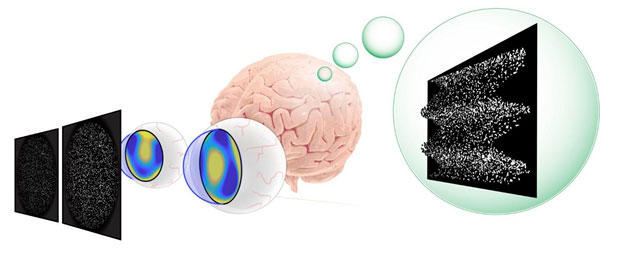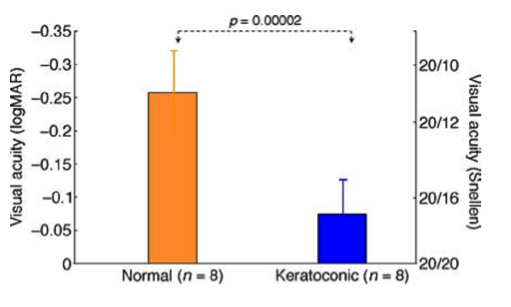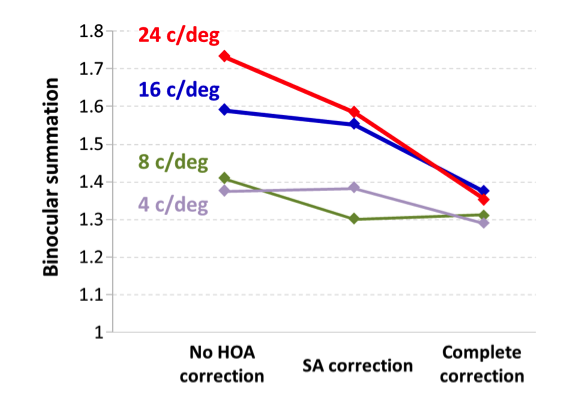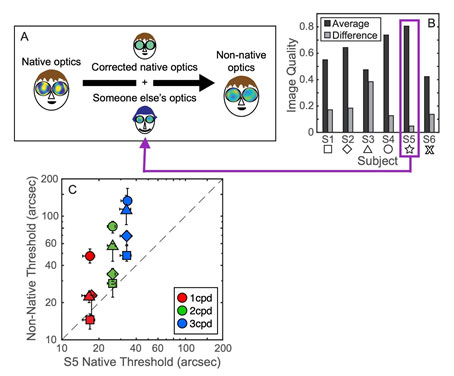
Advanced Physiological Optics Laboratory
Yoon Lab

The retinal image quality of the human eye is degraded by ocular aberrations. Lower-order aberrations, defocus and astigmatism, can be easily corrected using spectacles and contact lenses. Higher order aberrations cannot be corrected as easily, but fortunately do not affect visual performance as much in healthy eyes. However, the magnitude of these higher order aberrations could increase precipitously in ocular pathologies such as keratoconus, or even as a result of ocular surgery. Most people with these conditions then suffer from compromised vision in everyday living.

People are adapted to prefer the blur patterns induced by their own higher-order aberrations (Artal et al. 2004). Our own results showed that adaptation had caused perfect retinal images to be sub-optimally processed by neural mechanisms following prolonged experience with bad optics (Sabesan and Yoon 2009). Specifically, keratoconus patients were unable to perceive fine image details even when their higher order aberrations were corrected to near diffraction-limited quality using adaptive optics (Figure 2). This suggests that slow acting adaptive processes, acquired over long periods of bad keratoconic vision, were unable to keep up with immediate visual correction. By the same argument, we have also proven that these neural mechanisms that underlie vision can be restored following perceptual training with good optical quality (Sabesan and Yoon 2013).

Figure 2. Visual acuity for normal and keratoconic eyes after correction of all aberrations (Sabesan et al. 2009)
Binocular visual performance is typically better than monocular performance. This can be demonstrated in the example of contrast sensitivity by an effect known as binocular summation. We have shown that further improvements can be made by correcting for the intrinsic aberrations of the eye but the amount of summation is larger with the native higher order aberrations than without (Sabesan et al. 2012; Figure 3). We are currently examining the notion that adaptation had served to compensate for phasic shifts caused by the aberrations to undermine the binocular visual benefit during sudden optical correction. [not sure if this exposes our unpublished results- point for discussion]

Figure 3. Binocular summation for contrast sensitivity and different spatial frequencies, as a function of the optical quality. (Sabesan et al. 2012)
Stereovision is also affected by the ocular optics, as well as adaptation to the ocular optics. We showed that correcting for the higher-order aberrations significantly improves the finest discriminable depth, but the improvement is contingent on the native difference between the eyes (Ng et al., 2021). Ironically, people with larger natural aberrational difference do poorly with optical correction. We attribute this to neural adaptation and prove it in an experiment where inducing people with someone else’s aberrations caused stereoacuity to be worse than the person from whom the aberrations came (Figure 4).

Figure 4. Evidence that stereovision is adapted to the native optics, by measuring stereoacuity with someone else’s optics. (A) Experimental paradigm. (B) Subject S5 possessed the best optical quality in both eyes and the least amount of interocular difference. His aberrations were chosen to be induced the other subjects using adaptive optics. (C) Stereoacuity of the subjects (symbol coded in (B)) with S5’s optics, showing that people largely did worse even though they now had S5’s optics that was better than their own.